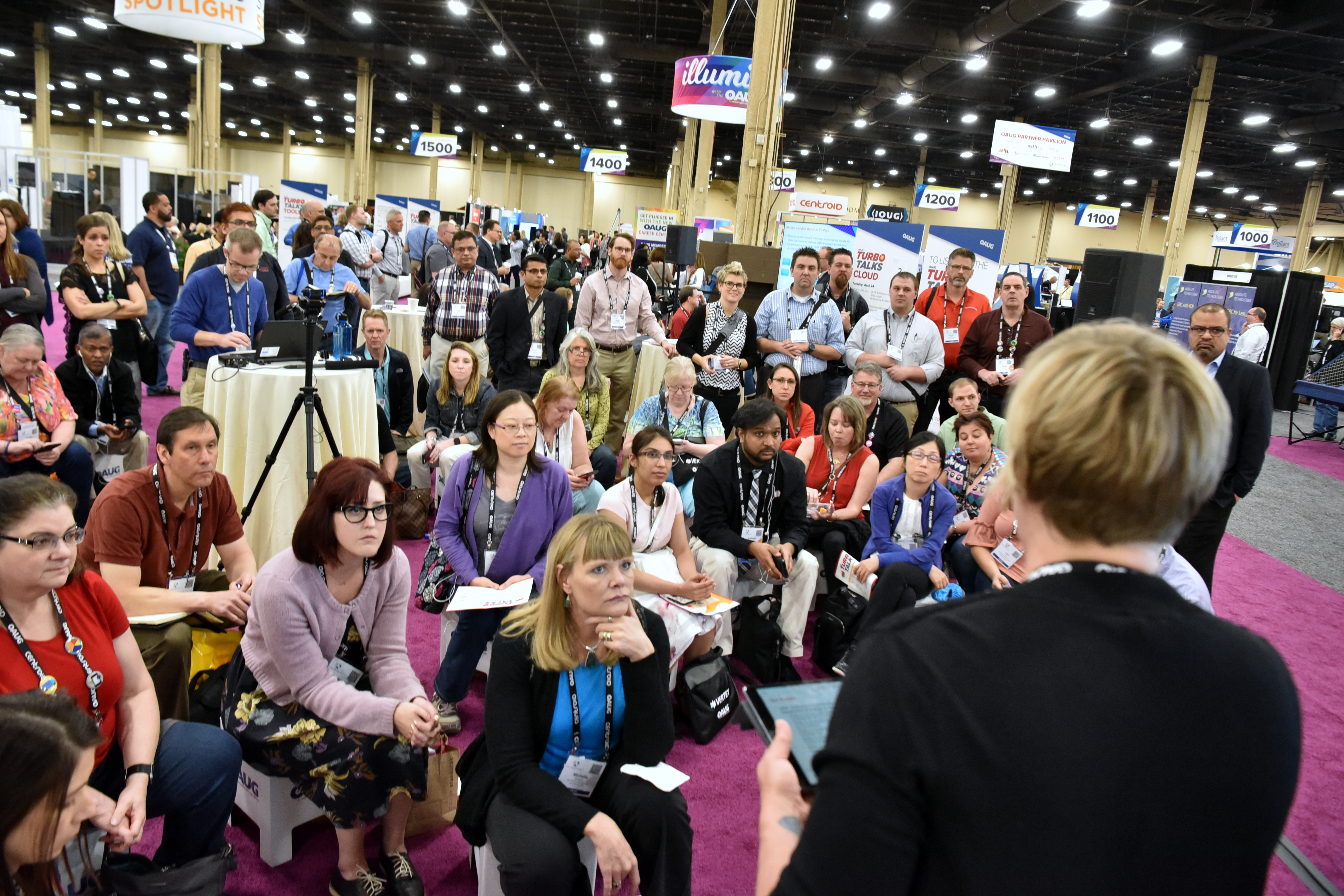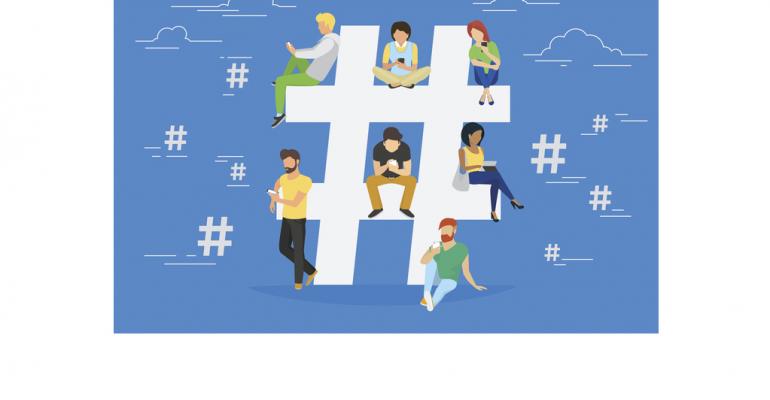As one of the last items on the schedule at Collaborate, the annual conference of the Oracle Applications Users Group, leadership asks the roughly 5,500 attendees to discuss and then vote on the hashtag for next year's event. Not only does this ensure that the hashtag is relevant and easy for everyone to remember, but it also creates instant momentum for generating a stream of social-media content across Twitter and LinkedIn that drives year-round peer-to-peer activity. And, of course, it makes marketing the event a whole lot easier.
Allison Dixon, senior director of marketing and creative services for Atlanta-based association- and event-management firm Meeting Expectations, oversees that marketing effort and then goes on site each April to act as event promoter and logistics troubleshooter. In fact, both of those duties rely heavily on the social media streams using the event hashtag.
On-Site Happenings
"With social media, our top priority is peer-to-peer marketing to the widest universe of users because the event is about sharing experiences with Oracle products, and all the sessions are designed for that," Dixon says. Through the hashtag—which for this year is #C19TX to acknowledge Texas as the host destination—"we want users collaborating and sharing what they are interested in learning, what they plan to participate in on site, and then what they are getting from their event experience as it's happening." To encourage maximum on-site participation, the scrolling Twitter feed is embedded in the conference app.
Interestingly, the users group's overarching goal in the next few years is to simply maintain the event's attendance figures. The reason: "Attendees' organizations are considering if, when, and how to migrate their technology to the cloud; there is so much change in the landscape for these on-premises users," Dixon says."We're trying to adapt cloud-focused content into the show while we continue to serve the on-premises base, and we understand there's a lot more event competition when you move into cloud territory."
As a result, tracking the hashtag for attendee satisfaction with sessions and networking opportunities is critical. First, "I monitor the social streams for people who share an 'aha!' moment they had, and contact them to see if they would meet up with my video team to do a 60-second testimonial," she says. "We get tons of footage across many topics." Further, Dixon tweets the location of the video team so attendees who want to volunteer to share their story can easily find them. While all that footage is useful throughout the year for marketing, some of it is immediately useful on social media too.

Allison Dixon, senior director of marketing and creative services, Meeting Expectations
Next, for any emerging confusion or problems on the show floor, "we often see those things mentioned on Twitter before our staff is notified about it—which is why I personally work on the social feeds most of each day," Dixon notes. "I consider myself the conference concierge."
Besides typical event glitches, there are more significant opportunities to impress attendees that social media provides Dixon's team. For instance, "while we haven't yet created any impromptu sessions to address a topic that emerged on social media, we can modify on-site content offerings in other ways," she says. "When there are posts saying a breakout room is standing room only, we try to get word out before the session ends that we've scheduled an encore presentation the next day." If necessary, prefunction or exhibit-hall space can act as the venue, depending on the presentation requirements. Another scenario: "If we hear that part of the venue is confusing to navigate—we held morning yoga classes out by the pool—we'll create short wayfinding videos and post them."
Another important social-media goal for the users group is capturing as much industry media coverage as possible. While the tech-focused journalists can monitor the social feeds before, during, and after the event to develop content, Dixon's year-round curation of the feeds supports the topics she pushes out to the trade-media outlets, making it easier for journalists to report on them. Lastly, "we create marketing kits for presenters and exhibitors that include graphics specifically designed for social media, so they can easily market their participation in the event and the hashtag to their networks."
One surprise Dixon got from social media was its ability to produce so many interest-group gatherings that were organized by attendees. "Informal community-building elements are really taking off through social channels," she says. In the past few years, an early-morning running group was organized using the hashtag, while another group developed a tradition of delivering fresh-baked brownies to a few exhibitor booths as a surprise thank-you and a social gathering opportunity, documented through Twitter posts.
On the other hand, not everything the group tried with social media was a success. Despite solid participation for the testimonial-video program, a selfie contest that asked attendees to photograph themselves in different spots around the event drew little interest. "Just because attendees are heavily into tech does not necessarily mean they are fans of all aspects of social media," Dixon notes. "Many of our people are not digital natives, and they can be a bit introverted. When they use social media, it is not about themselves. We learned a good lesson there."
Post-Event Strategies
After the conference ends, Dixon uses social-media content to maintain a relationship with attendees and nonattendees alike. First, "we re-read attendees' social media story lines and do word-cloud analysis to sharpen our understanding of how they speak about the topics they are most interested in. Then we match our vocabulary in marketing materials to theirs."
In contrast to a members-only Oracle users forum on LinkedIn, the Oracle Application Users Group recently launched its own organizational page on LinkedIn where all status updates are public and shareable. "It's great for my marketing," Dixon says. "People use the closed group for discussions and topical help, but the company page can do that too while allowing all of it to be shared far more widely."
What's more, each week the conference director at Meeting Expectations sends the users group's board of directors and conference planning committee a registration report, and Dixon adds in the upcoming topics and event features her team will be promoting via electronic channels the following week. "I provide them with pre-written content and graphics, but also strongly encourage them to post in their own words and share their personal testimony on the value of the event as busy tech-focused professionals themselves," she says. "It helps to give them seed content to get the ball rolling."
And beyond the business-events niche, "we look at the use of social media for large live events like South by Southwest, the Super Bowl, the World Cup, and the Olympic Games to figure out how we might apply their concepts to the association conference space. Those kinds of events always give us something we could adapt to the group's needs."

Quick Tip: Choosing Sessions as Social Media Content
"We identify a few conference sessions that are suitable for Facebook Live and broadcast those from the show," says Allison Dixon of Meeting Expectations, who works on the Oracle users group event. "We call them 'Turbo Talks.' For those, we make sure to have a reliable internet connection, preferably wired, and an audio feed from the system in the room. Ideally, we also have a way to switch between the camera feed and the slides; our digital marketing manager is the person working the camera."





